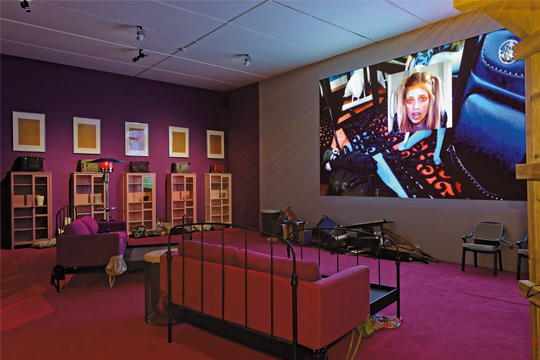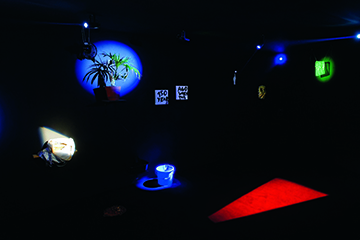THE 12TH BIENNALE DE LYON: “MEANWHILE…SUDDENLY, AND THEN”
| January 7, 2014 | Post In LEAP 24

Fitch, Common Shore,
2012
Installation view, 2013
Courtesy of the artists, the
New Gallery, Paris, and the
Biennale de Lyon 2013
A couple of things suggest that the 12th Biennale de Lyon is an attempt to sidestep the sober seriousness of many large-scale exhibitions. The first is the visual identity of the biennial, which is based on four portraits by New York-based photographer Roe Ethridge. One subject is a young, good looking guy with a black eye looking straight into the camera, another a blonde wearing a corporate button-down shirt blowing a chewing gum bubble that is a bit too close to the camera for comfort, and the other two of a pig looking away from the lens and a young woman in a pearl necklace, who seems completely desperate. Posters of said images hang everywhere around town, accompanied only by the title of the biennial in a trendy font: “Meanwhile… Suddenly, and Then.”
Stepping into the Musée d’art contemporain (MAC Lyon), the first work on view is Hannah Weinberger’s Every Other Year (2013), a pair of speakers playing a drum duet that sounds surprisingly harmonious, and once again conveys some sense of youthful radicalism. But this exhibition replaces a sense of cool with a feeling of poetics. This isn’t a very rocking biennial. In fact, it is extremely satisfying, and seems to touch upon every trope of the biennial—the shiny contemporary art museum, the disused industrial space (here the Sucrière, an old warehouse used mainly to store sugar) transformed into a beautiful white cube-like space, the disused industrial space left raw, and the local venue (in this case, the Saint-Just church) given over to one artist— as well as the title that says very little about the content of the exhibition, and the list of 60-plus artists.
The official theme, or the interest that led curator Gunnar B. Kvaran in his choice of artists and conceptualization of the Biennale, is the interest in narrative and storytelling, and new modes thereof. This in turn leads to a couple of threads that run through the exhibition: the first a reconsideration of the narrative structure of the presentation of artworks, the other a questioning of the stories art history tells us and an exploration of the boundaries of artistic mediums.
The obvious example for the interest in new display structures would be the work of Ryan Trecartin, who shows a collection of his over-the-top video installations made in collaboration with Lizzie Fitch between 2009 and 2012, introduced here as “sculpture-theater.” The biennial feels extremely spacious and uncluttered—especially at MAC, where each artist had a room dedicated to his or her work—and a number of artists leveraged this to create large-scale presentations questioning, well, standard presentation. One such example is Helen Marten, whose commissioned work Mad Particles (2012) is formed of older works which she reorganized for the exhibition in the hopes of creating new relations between them. Similarly, the London-based artist Laure Prouvost used the new commission to re-stage her impressive Before Before (2011), a poetic and maze-like installation of texts, sound, and video that relate, in a highly charged and sexual way, to Kafka’s Metamorphosis. Emerging from this maze visitors found themselves in the dark room of After After (2013), where sculptures and objects were illuminated in different intervals— a hypnotizing, engrossing “movie” that the artist refers as a “new kind of 3D film.”

2011
Installation, mixed media, sound and
video
Courtesy of the artist,
MOTInternational, London and
Brussels, Outset Contemporary Art
Fund, and the Biennale de Lyon 2013
This kind of rethinking of the medium echoes across the exhibition. The large majority of the artists Kvaran invited to participate in the Biennale are young, born in the late 1970s and early 80s—so it comes as no surprise that many of them work conceptually with media and technology. At times, it seems like in lieu of storytelling per se, a lot of the artwork are an attempt to organize information—perhaps a reaction to the over-availability of information online. Brazilian artist Gustavo Speridião commands notice for The Great Art History (2005–2013), in which he narrates images from the Life magazine archive that he bound together in a book by drawing and writing on them. An image of schoolboys in the 1950s, for example, is cited as “Bauhaus,” and Speridião’s rewriting and pinpointing posits that the death of punk, Tristan Tzara, and Vladimir Maiakovsky are more important than the history of wars, politics, or fame. A similar examination and reorganization of traditional storytelling is Ming Wong’s research of cinematic tropes in the three-screen installation Me in Me (2013), in which that artist assumes the roles of female archetypes of Japanese film from three eras: classical, modern, and virtual. He is the daughter looking to care for her father in the modern segment, a futuristic warrior in the virtual story, and a woman in search of a husband in the classical one. The male artist’s taking of female roles isn’t just a comment on gender, but also a statement on how narrative mediums can bend our expectations— as is his inclusion of a behind-the-scenes segment, which strips all illusion and presents narrative as a raw, almost dysfunctional system. Other examples of the failure of the medium to communicate data are Juliette Bonneviot’s Minimal Young Girl (2013)—the story of a young woman who tries to recycle the waste she creates and ends up honing in on the refuse she is surrounded by—or Weinberger’s other work for the Biennale, presented at the Sucrière, which is a trailer made of found footage for a movie that will never be made (Trailer, 2013).
The generous staging and hanging of works in both the Sucrière and MAC shows a lot of respect for the art. There is little sound bleed between the videos, lots of space for experimental installations, and a well-laid out floor plan that leaves room for generous wall texts. It’s a very professional looking installation—not to say expensive— that leaves a flavor of gratuitous politeness in the show. Why polite? There’s a certain feeling of complicity in Kvaran’s exhibition. Even though the curator can be commended for choosing to work with artists who are not the tried-and-tested Gen Xers we’re used to seeing in large-scale biennials, the market has already embraced many of these young artists, who with their very material, sellable works are represented by commercial galleries. But is a biennial’s role to discover and introduce the new, or say something about the existing status quo? Kvaran seems more interested in the latter, his strategy exemplifying real curator-artist dialogue—many of the works on view were new commissions. This curator’s priorities are well set. And confidently so: John Kelsey’s contribution to Lyon is a selection of texts culled from the artists’ writings for the Biennale’s catalogue, which were added to existing wall labels as quotes. This intervention in the make of the biennial—a “security threat” at the discursive level—is a refreshing reconsideration of an all-too-comfortable structure.
If a biennial may still serve to announce the arrival of a new generation, then the Biennale de Lyon does just that for a certain cohort of artists in their late twenties and early thirties who are reacting to the world they came of age into. This world owes itself first and foremost to the Internet, but also very much to globalization, the fumbling economy, questions of immigration and inclusion versus exclusion, and the translatability of culture. “To make sure you are not dead, we’re going to see if you’re alive,” reads a certain moment in Ed Atkins’ video Even Pricks (2013). If questions of narrative and storytelling seem outdated—see postmodernism and the proclaimed death of grand narratives—the choice of artists of this generation is redeeming, precisely because of the way they use technology to tell stories, while questioning said media at the same time. This biennial’s title says a lot about its content. “Meanwhile… Suddenly, and Then” is all about timing—which is apt, considering that what Kvaran has created here is an exhibition about the here and now.

